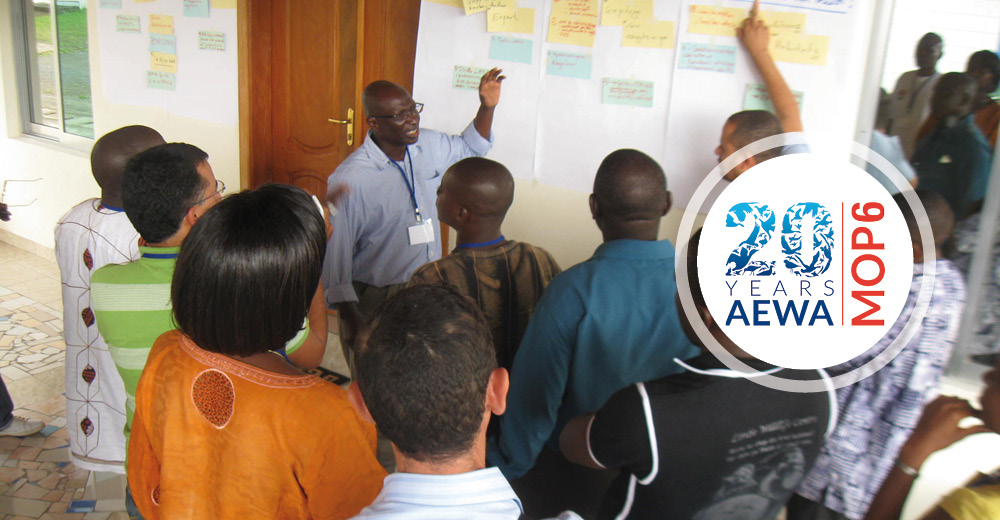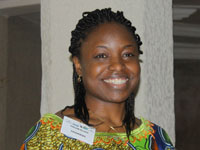Big Plans for Africa: A Round of Questions and Answers from AEWA Experts

Abdoulaye Ndiaye during a Training of Trainers Workshop in Cameroon
Bonn, 10 November 2015 - In preparation for the MOP6, we have sat down with AEWA experts to ask them about successes and challenges in their work, as well as future plans. Gathered around the table are Jacques Trouvilliez (AEWA Executive Secretary), Sergey Dereliev (AEWA Technical Officer) and Evelyn Moloko, who has served as the Coordinator for the AEWA African Initiative for the past six years, working with African Parties to promote the Agreement in the region.
What makes AEWA unique?
Jacques Trouvilliez: In order to survive, birds need habitats in different countries and on different continents. AEWA is the international treaty safeguarding migratory birds and their habitats along migration routes across Africa and Eurasia. Such flyway conservation is the most effective way to conserve migratory birds through cooperation of the countries.
Can you briefly introduce The African Initiative?
Evelyn Moloko: The African Initiative is a package of support measures which utilizes different approaches to implement AEWA in Africa. From the AEWA side, the African Initiative Coordinator is responsible for providing guidance to African Parties, and for raising funds for the key activities in the region and coordinating the efforts by various partners involved in waterbird conservation. Since the Initiative started in 2009, we have recruited ten new Parties from Africa — an unprecedented record since AEWA’s entry into force, and we will continue to encourage countries to join through AEWA promotion workshops.
And what are key AEWA activities in the region?
Jacques Trouvilliez: We need to invest the resources in areas where they will make the maximum impact. One of the main issues in the region is capacity-building. That is why we consider a crucial success the Memorandum of Understanding recently signed by three leading wildlife management schools in Africa — the Wildlife School in Garoua (Cameroon), the College of Wildlife Management in Mweka (United Republic of Tanzania) and the Kenya Wildlife Service Training Institute in Naivasha. They all agreed to include in their curricula the training kit on the flyway approach to waterbird and wetland conservation, which we developed in collaboration with our partners. People who take this training will pass on what they learned to others, thus building the knowledge base in the region where it will be used. This is essential for the success of our conservation efforts, and this approach is the keystone of our “Training of Trainers” concept.
What other approaches are crucial for the success of the African Initiative?
Jacques Trouvilliez: We need to convince people that conserving biodiversity is not a luxury — it is a prerequisite for improving livelihoods. We need to remember that while nature conservation is science-based, it is always a human story, and we need to create an alliance that is mutually beneficial for both birds and people. It is not only a matter of raising awareness, but also of creating incentives and finding innovative solutions.
Could you provide an example of a successful project that illustrates this idea?
-Wetlands-International-Africa-and-AIV-at-the-Ndiael-Avifauna-Special-Reserve-in-Senegal.jpg) |
-Wetlands-International-Africa.jpg) |
|
© Wetlands International Africa and AIV at the Ndiael Avifauna Special Reserve in Senegal |
Ndiaël Avifauna Special Reserve, Senegal © Wetlands-International-Africa |
Sergey Dereliev: A good example is a project in Berga, Ethiopia, where AEWA has supported conservation work through its Small Grants Fund. The community is located next to a highland wetland which is the only known breeding ground for the White-winged Flufftail, a critically endangered species. What used to be a common landscape is disappearing rapidly due to intense development of agriculture, and White-winged Flufftail habitats have been lost along the way. To safeguard this last breeding site, we needed to involve the locals who own the land and whose livelihoods depend on it. As part of our Action Plan for this species, we have cooperated with several NGOs, which built a school for the community where children have not had access to education so far. The school is called the White-winged Flufftail School, and the topics of conserving the birds and preserving natural heritage are part of the school curriculum. A group of local volunteers formed the Site Support Group — about 70 conservation-minded people — to monitor the site and ensure that it is managed sustainably for the Flufftail. The Berga community has taken the ownership of the Flufftail, and it became an investment in the future for everyone involved.
Which factors do you consider crucial for the success of your efforts?
Jacques Trouvilliez: The demographic pressure in Africa will increase tremendously in the next few years. People will be moving to the cities in search of jobs. Intensive agriculture methods will also spread, modifying the land use. When a city expands, the nearby wetlands are frequently destroyed in the process, because they are seen as wastelands. People don’t really appreciate the value these habitats represent, and not just for birds. To improve the process of spatial planning, we need to assess the status of a wetland beforehand — identifying whether it is a key stopover site for migratory birds. For example, the Whimbrel, a large wading bird, uses stopover sites along his flyway from the high Artic to the southern tip of Africa — it is a long-distance migrant with long flights. If you destroy one stopover site, it will be like breaking a link off a zipper: it will not work. The distance between sites will become too great, the birds will not have enough energy to skip a stop in their journey and will perish.
What other major conservation issues exist in the region and who needs to be involved to resolve them?
Evelyn Moloko: The impact of fisheries on seabird conservation is a serious issue, particularly for Southern African countries. This will be discussed at AEWA MOP6 along with the multi-species action plan for seabirds, the very first one developed under AEWA; it involves South Africa, Namibia and Angola.
Sergey Dereliev: The fish stocks that the bird colonies depend on are being depleted through unsustainable fishing. If the fish disappear, so will the bird colonies, because there are no other resources to sustain them.
The other issue is bycatch. We need to ensure that fisheries start using bird-safe hooks or other bird-safe fishing methods. This will of course entail increased costs. We need to find ways to convince fishing nations to introduce mandatory bird-safe standards. Some of these issues will be brought to the attention of MOP6: these are the recommendations, how shall we proceed? It is a new area of work for us, and a new challenge that will require cooperation with intergovernmental treaties and conventions covering high seas.
How do you advance the idea of birds and people sharing wetlands for mutual benefit?
Jacques Trouvilliez: We need to promote the concept of investing in the future, and provide a combination of alternatives, ways to create new sources of livelihood. Ecotourism is one of the possible solutions in our toolbox, but not the only one. During MOP6 we will present the Tri-annual Waterbird Conservation Awards, and one of the winners this year is the Inter-Village Association (AIV) of Ndiaël. It unites 32 villages in Northern Senegalaround the Ndiaël Avifauna Special Reserve. An infrastructure development in the 1960s led to drying out of the local floodplain. Combined with the human pressure on natural resources, it resulted in the loss of the large majority of waterbirds from the site.
Supported by the government and NGOs, the association of villages has been working since 2004 to restore the floodplain along with its biodiversity, and at the same time strengthen the livelihoods of the rural population.Among the project highlights is the construction of a breeding site for pelicans and a viewpoint for eco-tourism.
What are your plans for the future?
Evelyn Moloko: The Plan of Action for Africa proposes to conduct five major livelihood projects, one for each region of the continent, to demonstrate the alternatives to using wetlands. We will need to pull it all together and demonstrate the value: if it stays managed the way it is now, the value remains as it is, if you switch to ecotourism for example, there is high potential for added value. And once established, these demonstration sites would need to be economically viable. This project will require finding major investors, international and local organizations to cooperate with — this is our next big challenge. We need to ensure that the wildlife resources of the continent are used sustainably so that tomorrow and the day after the future generations can appreciate this beauty, the colorful mixture of different species that is African biodiversity.

Evelyn Moloko
An Agricultural Engineer and Natural Resources Manager, Evelyn has been exposed to various and sometimes conflicting demands the need for natural resources presents — from their use to ensure food security to their role in the conservation of biodiversity.
Evelyn has initially collaborated with AEWA as the Assistant Advisor for the African region at the Ramsar Convention Secretariat during the organization of a Ramsar field advisory mission in February 2008. The mission involved UNEP/AEWA and UNEP/CMS Secretariats and addressed issues of sustainable use and management of the Lake Natron Basin Ramsar Site in connection with development of a soda ash extraction facility.
Following the launch of the AEWA African Initiative in 2009, Evelyn has supported the UNEP/AEWA Secretariat as the Coordinator for the Initiative. She has worked to promote the implementation of the Agreement in Africa, and has served as a key driving force behind the success of the Initiative.
Last updated on 10 November 2015


